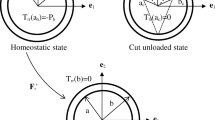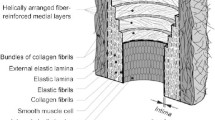Abstract
A general theory for computing and identifying the stress field in a residually stressed tissue is presented in this paper. The theory is based on the assumption that a stress free state is obtained by letting each point deform independently of its adjacent points. This local unloading represents an initial strain, and can be described by a tangent map. When experimental data is at hand in a specific situation, the initial strain field may be identified by stating a nonlinear minimization problem where this data is fitted to its corresponding model response. To illustrate the potential of such a method for identifying initial strain fields, the application to an in vivo pressure–radius measurement for a human aorta is presented. The result shows that the initial strain is inconsistent with the strain obtained with the opening-angle-method. This indicates that the opening-angle-method has a too restrictive residual strain parameterization, in this case
Similar content being viewed by others
References
Choung CJ, Fung YC (1986) Residual stress in arteries. In: Schmidt-Schnbien GW, Woo SL-Y, Zweifach BW (eds) Frontiers in biomechanics. Springer, Berlin Heidelberg New York, pp 117–129
Fung YC (1983a) On the foundations of Biomechanics. J Appl Mech 50:1003–1009
Fung YC (1983b) Biomechanics: circulation. Springer, Berlin Heidelberg New York
Greenwald SE, Moore JE Jr, Rachev A, Kane TPC, Meister J-J (1997) Experimental investigation of the distribution of residual strains in the artery wall. ASME J Biomed Eng 119:438–444
Han HC, Fung YC (1996) Direct measurement of transverse residual strains in aorta. Am J Physiol 270:H750–H759
Holzapfel GA, Gasser TC, Ogden RW (2000) A new constitutive framework for arterial wall mechanics and a comparative study of material models. J Elasticity 61:1–48
Humphrey JD (2002) Cardiovascular solid mechanics; cells, tissues, and organs. Springer, Berlin Heidelberg New York
Johnson BE, Hoger A (1995) The use of a virtual configuration in formulating constitutive equations for residually stressed elastic materials. J Elasticity 41:177–215
Liu SQ, Fung YC (1998) Zero-stress state of arteries. ASME J Biomed Eng 110:82–84
Ljung L (1999) System identification; theory for the user. Prentice Hall PTR, Upper Saddle River, NJ
Lubarda VA (2004) Constitutive theories based on the multiplicative decomposition of deformation gradien: thermoelasticity, elastoplasticity, and biomechanics. Appl Mech Rev 57:95–108
Manken R, Stein E (1997) Concepts and computational methods for parameter identification of inelastic material models. In: Owen DRJ, Oñate E, Hinton E (eds) Computational plasticity, CIMNE
Marsden JE, Hughes TJR (1994) Mathematical foundations of elasticity. Dover Publications, New York
Matsumoto T, Goto T, Furukawa T, Soto M (2004) Residual stress and strain in the lamellar unit of porcine aorta: experiments and analysis. J Biomech 37:807–815
McDonald DA (1974) Blood flow in arteries. Edward Arnold, London
Miehe C (1996) A constitutive frame of elastoplasticity at large strains based on the notion of a plastic metric. Int J Solids Struct 15:3859–3897
Ogden RW (2003) Nonlinear elasticity, anistropy, material stability and residual stresses in soft tissues. In: Holzapfel GA, Ogden RW (eds) Biomechanics of soft tissues in cardiovascular systems, no 441, CISM courses and lectures. Springer, Berlin Heidelberg New York, pp 65–108
Rachev A, Greenwald SE (2003) Residual strains in conduit arteries. J Biomech 36:661–670
Rodriguez EK, Hoger A, McCulloch AD (1994) Stress-dependent finite growth in soft elastic tissues. J Biomech 27:455–467
Schulze-Bauer CAJ, Holzapfel GA (2003) Determination of constitutive equations for human arteries from clinical data. J Biomech 36:165–169
Schulze-Bauer CAJ, Auer M, Holzapfel GA (2002a) Layer-specific residual deformations of aged human aortas. In: 13th conference of the European society of biomechanics, 1–4 Sept, Wroclaw, Poland
Schulze-Bauer CAJ, Regitnig P, Holzapfel GA (2002b) Mechanics of the human femoral adventitia including the high-pressure response. Am J Physiol Heart Circ Physiol 282:H2427–H2440
Schulze-Bauer CAJ, Mörth C, Holzapfel GA (2003) Passive biaxial mechanical response of aged human iliac arteries. ASME J Biomech Eng 125:395–406, DOI: 10.1115/1.1574331
Sonneson B, Hansen F, Stale H, Länne T (1993) Compliance and diameter in the human abdominal aorta. Eur J Vasc Sur 7:690–697
Sonneson B, Länne T, Vernersson E, Hansen F (1994) Sex difference in the mechanical properties of the abdominal aorta in human beings. J Vasc Surg 20:959–969
Stålhand J, Klarbring A, Karlsson M (2004) Towards in vivo aorta material identification and stress estimation. Biomech Model Mechanobiol 2:169–186
Taber LA, Humphrey JD (2001) Stress-Modulated growth, residual stress, and vascular heterogenity. ASME J Biomed Eng 123:528–535, DOI 10.1115/1.1412451
Takamizawa K, Hayashi K (1987) Strain energy density functions and uniform strain hypothesis for arterial mechanics. J Biomech 20:7–17
Takamizawa K, Matsuda T (1990) Kinematics for bodies undergoing residual stress and its application to the left ventricle. J Appl Mech 57:321–329
Truesdell C, Noll W (1965) The non-linear field theories of mechanics. Springer, Berlin Heidelberg New York
Vaishnav RN, Vossoughi J (1983) Estimation of Residual Stress in Aortic Segments. In: Hall CW (eds) Biomedical Engineering II: Recent Developments. Pergamon Press, New York, pp 330–333
Vossoughi J, Hedjazi Z, Borris FS (1993) Intimal residual stress and strain in large arteries. In: 1993 ASME advances in bioengineering, ASME, pp 434–437
Author information
Authors and Affiliations
Corresponding author
Rights and permissions
About this article
Cite this article
Olsson, T., Klarbring, J.S.A. Modeling initial strain distribution in soft tissues with application to arteries. Biomech Model Mechanobiol 5, 27–38 (2006). https://doi.org/10.1007/s10237-005-0008-8
Received:
Accepted:
Published:
Issue Date:
DOI: https://doi.org/10.1007/s10237-005-0008-8




